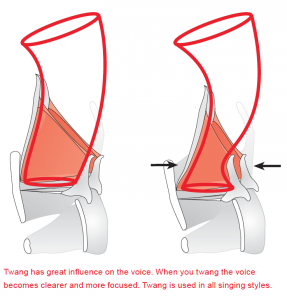The ‘Epiglottic Funnel’
Above the vocal cords are two quadrangular membranes known as the ‘quadrate membranes’. Together with the epiglottis at the front and the arytenoid cartilages at the back, they form a funnel like a horn. The sides of this funnel are called the ‘aryepiglottic folds’. The whole funnel is called the ‘epiglottic funnel’. You can see the rim of this funnel, or this horn, when you look down the throat with a mirror or a fibrescope. This funnel/horn can be shaped in many ways which affects the voice and its sound colour.


Necessary twang
When twanging, the opening of the epiglottic funnel is made smaller by bringing the  arytenoid cartilages closer to the lower part of epiglottis (the petiole) whereby the sound gets clearer and non-breathy and you can increase your volume by 10 – 15 db. You always need some twang, which is called ‘necessary twang’, on the notes in order to have correct technique and to achieve easy, unhindered use of the voice, regardless of the mode, sound colour and effect used. Necessary twang makes it easier to sing in all ways. For many this necessary twang does not sound twanged at all, but a trained ear is able to hear that a certain amount of twang is involved. 164
arytenoid cartilages closer to the lower part of epiglottis (the petiole) whereby the sound gets clearer and non-breathy and you can increase your volume by 10 – 15 db. You always need some twang, which is called ‘necessary twang’, on the notes in order to have correct technique and to achieve easy, unhindered use of the voice, regardless of the mode, sound colour and effect used. Necessary twang makes it easier to sing in all ways. For many this necessary twang does not sound twanged at all, but a trained ear is able to hear that a certain amount of twang is involved. 164
If you add even more twang than this you can achieve a sharper and more penetrating, snarling character, like a cackle. This is called ‘distinct twang’. The more twang (i.e. the more the funnel is squeezed), the sharper the sound.
Thus, we are distinguishing between ‘necessary twang’ to obtain clear, unhindered notes with correct technique and ‘distinct twang’ to obtain a sharper character and lighter sound colour.
As a singer it is important to practise your twang, both the necessary and the distinct one, partly in order to obtain clear, free notes and partly to be able to alter the sound colour.
Distinct Twang
When the opening of the funnel is made EVEN smaller by bringing the epiglottis closer to the arytenoid cartilages, the sound assumes a much sharper and more penetrating, snarling character, like a cackle. This is known as ‘distinct twang’. The more squeezed the funnel, the more snarling the sound.
| #163 (Female) #163 (Male) |
Distinct twang is used, for example, in the stereotypical American way of speaking (the Southern accent) and often in country music. It is often mistaken for nasality but has nothing to do with it. In twang, the sound may come through the mouth and/or through the nose.
Distinct twang and vowels
Distinct twang works best with the vowels ‘EE’ (as in ‘see’), ‘I’ (as in ‘sit’), ‘EH’ (as in ‘stay’), ‘OE’ (as in ‘herb’), and ‘A’ (as in ‘and’) because the tongue in these cases is positioned against the molars in the upper part of the mouth which helps in twanging the epiglottic funnel. ‘OH’ (as in ‘so’), ‘O’ (as in ‘woman’), ‘OO’ (as in ‘you’), and ‘AH’ (as in ‘far’) are problematic because in these vowels the back of the tongue is lowered causing you to lose the twang of the epiglottic funnel. In distinct twang ‘OH’, ‘O’, ‘OO’ is changed into sounding more like an ‘OE’ (as in ‘herb’). ‘OH’ (as in ‘so’) is changed into ‘OEH’. ‘O’ is changed into ‘OE’. ‘OO’ is changed into ‘OOE’. ‘AH’ is changed into ‘A’.
Practise each vowel separately. Listen for the exact vowel sounds in the CVT Sound Library.
The vowel ‘EE’ (as in ‘see’) with distinct twang
| #031 (Female) #031 (Male) |
The vowel ‘I’ (as in ‘sit’) with distinct twang
| #032 (Female) #032 (Male) |
The vowel ‘EH’ (as in ‘stay’) with distinct twang
| #033 (Female) #033 (Male) |
The vowel ‘A’ (as in ‘and’) with distinct twang
| #034 (Female) #034 (Male) |
The vowel ‘OO’ (as in ‘you’) with distinct twang
| #035 (Female) #035 (Male) |
The vowel ‘O’ (as in ‘woman’) with distinct twang
| #036 (Female) #036 (Male) |
The vowel ‘OH’ (as in ‘so’) with distinct twang
| #037 (Female) #037 (Male) |
The vowel ‘AH’ (as in ‘far’) with distinct twang
| #038 (Female) #038 (Male) |
The vowel ‘OE’ (as in ‘herb’) with distinct twang
| #039 (Female) #039 (Male) |
The vowel ‘UH’ (as in ‘hungry’) with distinct twang
| #040 (Female) #040 (Male) |
